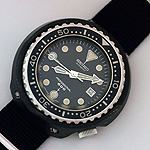 We’ve got something different for this week’s Fratello Friday. For a while, we’ve had a Seiko expert on board Fratello Watches by the name of Michael Stockton and one of his personal interests are (vintage) Seiko and Grand Seiko watches. This week, we bring you one of his stories, about the Seiko 6159-7010 also known to Seiko fans as the “Grandfather Tuna.”
We’ve got something different for this week’s Fratello Friday. For a while, we’ve had a Seiko expert on board Fratello Watches by the name of Michael Stockton and one of his personal interests are (vintage) Seiko and Grand Seiko watches. This week, we bring you one of his stories, about the Seiko 6159-7010 also known to Seiko fans as the “Grandfather Tuna.”
The modern version of this model, known in today’s Seiko collection as the Marinemaster Professional (or “Emperor Tuna”), is bound to get a few new cousins at the upcoming Baselworld 2015 show. But first things first: let’s give you some more explanation on this quintessential 1975 Seiko divers’ watch.
So there I was, fighting inescapable jet lag while meandering the halls of the surreal world that is Nakano Broadway. If you’ve never been to Nakano, it’s a haven for the otaku who collect anything (and everything) related to the world of Japanese manga. So why was I in this people-watching Mecca and why are you reading about it on a site devoted to watches? Nakano Broadway houses several pre-owned watch shops including the well-known and worthwhile Jack Road. It is also home to many shops selling consignment items, which include everything from toys to antiques to… more watches. It was on this day, in January, that I entered an overstuffed, messy consignment shop, filled mainly with odd display cases of action figures, when I spied something that I had long been craving: the Seiko 6159- 7010 “Grandfather” Tuna.
After a nearly three-year search for this watch, I don’t think I could have written a more storybook ending. I’ll attempt to shed a little light on why this watch is so unique and desirable. Once I’ve whetted your appetite, I’ll endeavor to share some impressions on its modern successor, the Seiko Marinemaster Professional “Emperor” Tuna.
A quick search on the Seiko 6159-7010 will bring up the familiar story of why the original Tuna was created by Seiko. Complaints by Japanese professional divers in the late 1960s about watch failures at working depths led to a serious undertaking by Seiko to design a true, effective tool watch that could withstand all the pressures of working while submerged. The result came in 1975: the Seiko 6159-7010 Professional. Its industry-first features included the titanium case, ceramic-coated titanium shroud, L-shaped gasket, and vented rubber strap. With a 600-meter depth rating, the 6159 also went without a helium release valve. Visually, the most distinctive element of the Seiko 6159-7010 is its screwed-on shroud which gives the watch it’s “tuna can” profile, and hence nickname. The shroud protects the case while also allowing for two access points to spin the bidirectional bezel. Of course, this shroud adds a lot of visual mass and creates the 50.5-mm case diameter. Inside the watch beats the 6159a, a Grand Seiko-derived 36,000-vph automatic movement. It hacks and can be hand wound. Date changing is quick-set. There’s no doubt that Seiko pulled out all the stops for this piece. Incidentally, the Seiko 6159-7010 (also marketed as the 7019 outside of Japan) was made from 1975 until early 1979.
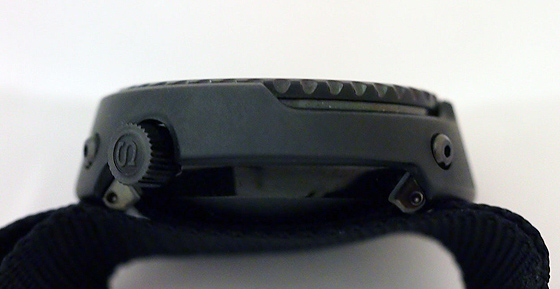
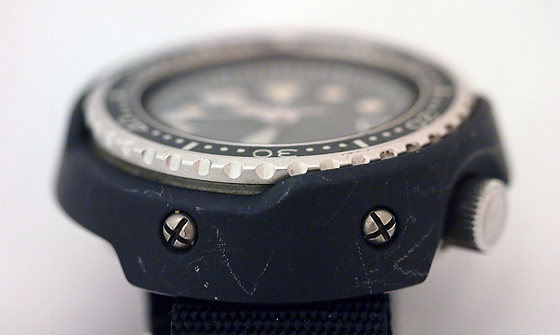
Aside from the technical innovation, what is the Seiko 6159-7010 like to view, handle and, most importantly, wear? The 6159 is not pretty. It is not going to battle with the Rolex Submariner for the title of “tool watch most likely to be worn to a board meeting.” Rather, it looks brutally effective for its purpose — think Rambo knife and you’re in the right ballpark — and will most likely be worn very casually. The deeply set dial is one of classic simplicity that has stood the test of time; it has been largely carried forward to today’s renditions of the Tuna. The Seiko 6159-7010 dial and caseback show the Suwa symbol denoting its place of build. It’s extremely clear, and everything from the markers, the hour and minute hands, and the iconic lollipop sweep hand are sized perfectly. Even the date window is nicely detailed yet unobtrusive; perhaps current watch designers should take a lesson. Seiko chose to outfit this model with its proprietary Hardlex mineral glass. Returning to the caseback, the tsunami motif that is used today on Seiko’s dive watches is proudly shown. When strapping this one on, let’s be thankful that Seiko decided to use titanium as a medium, because this watch is still a heavy little nugget.
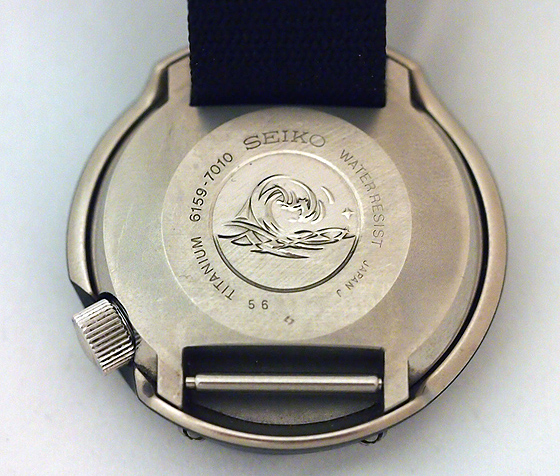
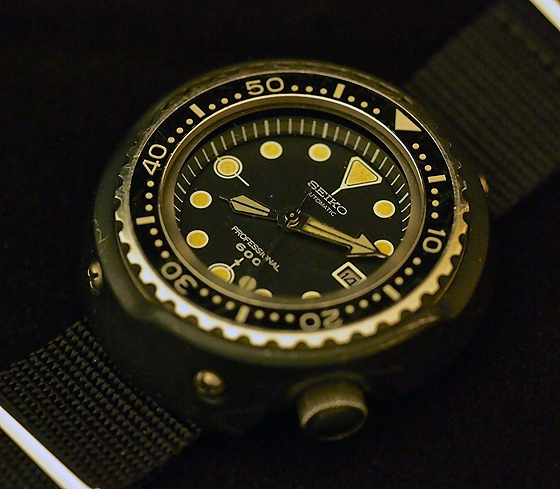
As far as wearability, a lot has been made about the height of the Seiko Tunas and the genetic requirement of a big wrist. Well, as a watch lover, I have been cursed with an extremely small wrist and I can tell you that the Seiko 6159-7010, and all other Tuna models, work for me. The key to such a great fit lies with the integrated lugs. My only modification is to use a thin, 22-mm NATO strap, as the original Seiko rubber straps are too long for me and prop up the case away from my wrist. Regarding watch height, it is true that you won’t likely be sliding this under your slim-fit dress shirt, and it may end up denting furniture. Onto the usable parts: the bezel is a slightly clattery, bidirectional 60-click affair that has nice click detents and a surprisingly good tactile feel. Meanwhile, the crown is a big beast that screws in nicely. Date changes occur with a precision click.
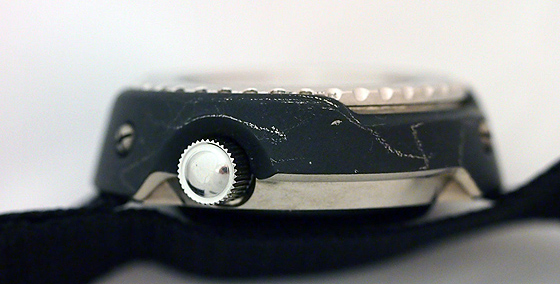
Let’s discuss a little about this specific piece and I’ll give some topical buying advice. The piece shown here is an early 1975 execution of the Seiko 6159-7010 because it lacks the “m” for “meters” next to the depth rating. It’s more rare than the “m” version and, some would say, more valuable. How much more valuable? Well, that’s tricky, because I simply have not seen many 6159 Tunas for sale before or after I found this one. This was an expensive watch when released and was likely not made in truly massive quantities. Common places to look for 6159s are, of course, eBay and the brand-only forums. Prices seem to range from $1,200 for rough examples to over $2,000 for better examples, but bidding seems to fluctuate wildly. Popularity for vintage Seikos, and most vintage watches, is on the rise, so assume that values will continue to creep in an upward direction. Look out for chipped shrouds, stripped crown tubes, missing or stripped shroud screws and signs of water entry. Shrouds are scratched easily, but I consider this to be surface character. Parts such as bezels, shrouds, dials are VERY difficult to find, so this is not a watch that I would recommend buying as an incomplete project unless you are highly patient. Thankfully, this is a stout movement, so durability seems to be a hallmark. If you’re not one for vintage pieces but like the look of the 6159, Seiko did release a Historical Collection piece called the SBDX005 in a limited edition of 1,000 pieces. These rarely show up and prices are normally above those of the Seiko 6159-7010. The piece is cosmetically very similar to the original save for a different movement, an additional 1 mm of diameter, and a different sweep hand. Personally, I really enjoy my Seiko 6159-7010 and feel lucky to have found it. It runs with extreme accuracy and is a fantastic conversation piece.
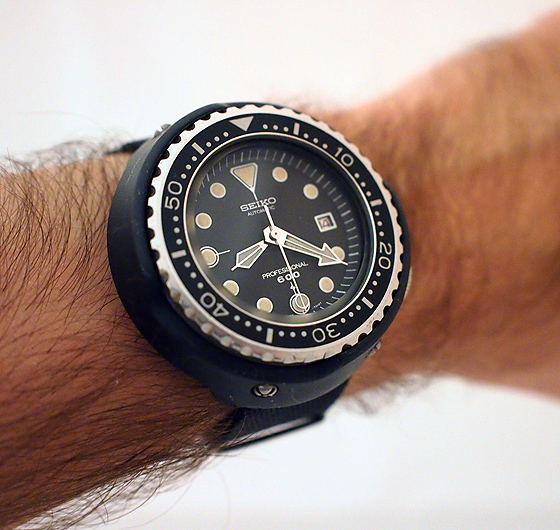
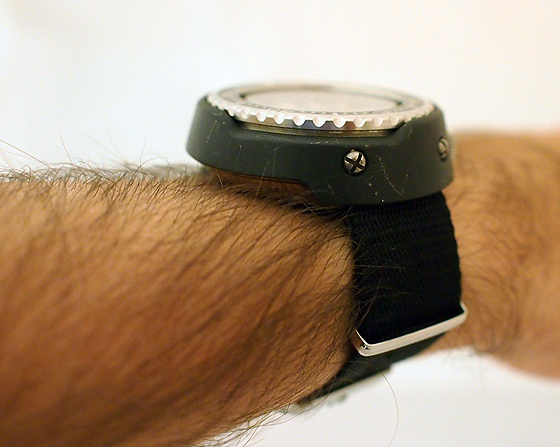

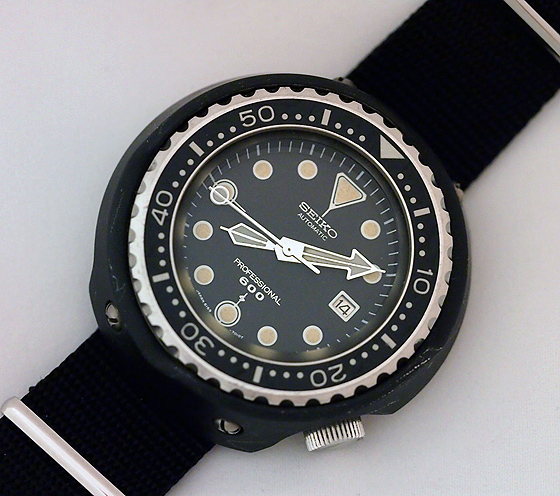
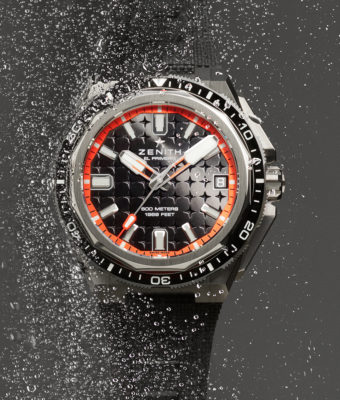
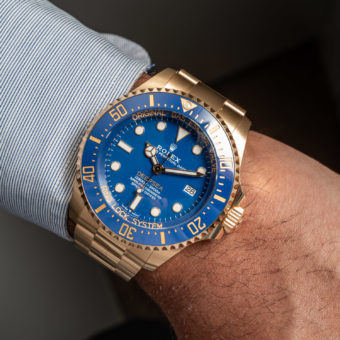
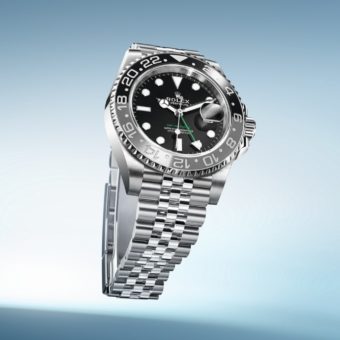

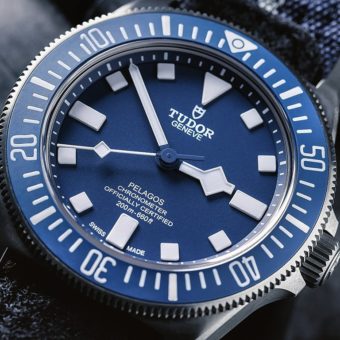
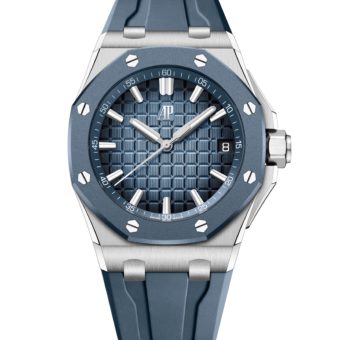
Ma786sai
What do you think about the 2020 1100 piece Ltd 1000m Tuna SLAO41 with 8L35 a homage to the 1975 6159-7010 GrandFather 600m. Cyrus
I wanted to know your thoughts on the 2020 Ref SLAO41 1000m Tuna of 1100 pieces. Is it a true representation of the 6159-7010 600 GrandFather Tuna? Is YES I will obtain it. Cyrus
Wonderful article – it is on my list of watches to own!